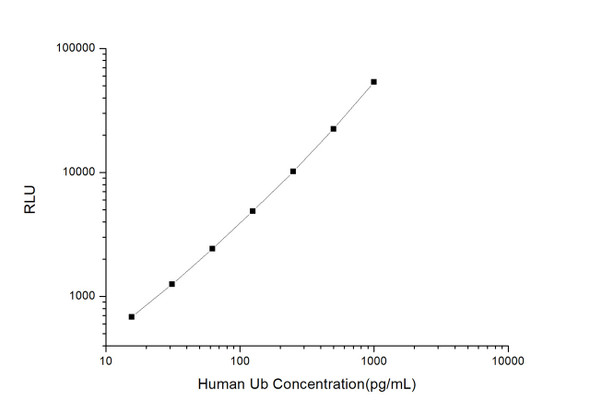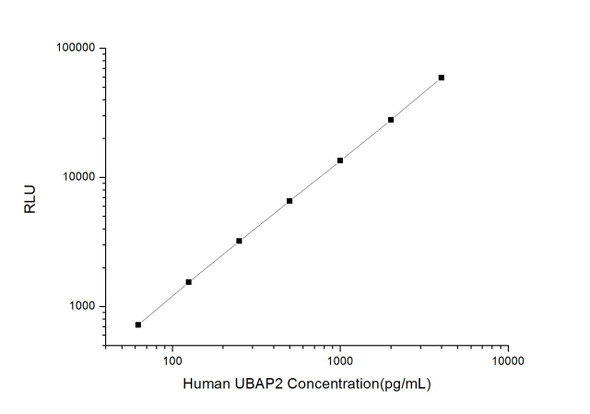Human Signal Transduction ELISA Kits
Human SUMO2 (Small Ubiquitin Related Modifier 2) CLIA Kit (HUES01141)
- SKU:
- HUES01141
- Product Type:
- ELISA Kit
- ELISA Type:
- CLIA Kit
- Size:
- 96 Assays
- Sensitivity:
- 37.5pg/mL
- Range:
- 62.5-4000pg/mL
- ELISA Type:
- Sandwich
- Synonyms:
- HSMT3, SMT3B, SMT3H2
- Reactivity:
- Human
- Sample Type:
- Serum, plasma and other biological fluids
- Research Area:
- Signal Transduction
Description
| Assay type: | Sandwich |
| Format: | 96T |
| Assay time: | 4.5h |
| Reactivity: | Human |
| Detection method: | Chemiluminescence |
| Detection range: | 62.50-4000 pg/mL |
| Sensitivity: | 37.50 pg/mL |
| Sample volume: | 100µL |
| Sample type: | Serum, plasma and other biological fluids |
| Repeatability: | CV < 15% |
| Specificity: | This kit recognizes Human SUMO2 in samples. No significant cross-reactivity or interference between Human SUMO2 and analogues was observed. |
This kit uses Sandwich-CLIA as the method. The micro CLIA plate provided in this kit has been pre-coated with an antibody specific to Human SUMO2. Standards or samples are added to the appropriate micro CLIA plate wells and combined with the specific antibody. Then a biotinylated detection antibody specific for Human SUMO2 and Avidin-Horseradish Peroxidase (HRP) conjugate are added to each micro plate well successively and incubated. Free components are washed away. The substrate solution is added to each well. Only those wells that contain Human SUMO2, biotinylated detection antibody and Avidin-HRP conjugate will appear fluorescence. The Relative light unit (RLU) value is measured spectrophotometrically by the Chemiluminescence immunoassay analyzer. The RLU value is positively associated with the concentration of Human SUMO2. The concentration of Human SUMO2 in the samples can be calculated by comparing the RLU of the samples to the standard curve.
| UniProt Protein Function: | SUMO2: Ubiquitin-like protein that can be covalently attached to proteins as a monomer or as a lysine-linked polymer. Covalent attachment via an isopeptide bond to its substrates requires prior activation by the E1 complex SAE1-SAE2 and linkage to the E2 enzyme UBE2I, and can be promoted by an E3 ligase such as PIAS1-4, RANBP2 or CBX4. This post-translational modification on lysine residues of proteins plays a crucial role in a number of cellular processes such as nuclear transport, DNA replication and repair, mitosis and signal transduction. Polymeric SUMO2 chains are also susceptible to polyubiquitination which functions as a signal for proteasomal degradation of modified proteins. Homotrimer (Potential). Crystal packing analysis suggests a possible trimeric assembly, of which the biological significance remains to be determined. Interacts with SAE2 and UBE2I. Covalently attached to a number of proteins. Interacts with PELP1. Interacts with USP25; the interaction sumoylates USP25. Broadly expressed. Belongs to the ubiquitin family. SUMO subfamily. 2 isoforms of the human protein are produced by alternative splicing. |
| UniProt Protein Details: | Protein type:Ubiquitin-like modifier Chromosomal Location of Human Ortholog: 17q25. 1 Cellular Component: nucleoplasm; PML body; nucleus Molecular Function:protein binding; ubiquitin protein ligase binding Biological Process: protein sumoylation; cellular protein metabolic process; positive regulation of proteasomal ubiquitin-dependent protein catabolic process; post-translational protein modification |
| NCBI Summary: | This gene encodes a protein that is a member of the SUMO (small ubiquitin-like modifier) protein family. It functions in a manner similar to ubiquitin in that it is bound to target proteins as part of a post-translational modification system. However, unlike ubiquitin which targets proteins for degradation, this protein is involved in a variety of cellular processes, such as nuclear transport, transcriptional regulation, apoptosis, and protein stability. It is not active until the last two amino acids of the carboxy-terminus have been cleaved off. Numerous pseudogenes have been reported for this gene. Alternate transcriptional splice variants, encoding different isoforms, have been characterized. [provided by RefSeq, Jul 2008] |
| UniProt Code: | P61956 |
| NCBI GenInfo Identifier: | 378405233 |
| NCBI Gene ID: | 6613 |
| NCBI Accession: | P61956. 3 |
| UniProt Secondary Accession: | P61956,P55855, Q32Q42, Q6IPZ6, Q96HK1, B2R4I2, |
| UniProt Related Accession: | P61956 |
| Molecular Weight: | 95 |
| NCBI Full Name: | Small ubiquitin-related modifier 2 |
| NCBI Synonym Full Names: | small ubiquitin-like modifier 2 |
| NCBI Official Symbol: | SUMO2 |
| NCBI Official Synonym Symbols: | HSMT3; SMT3B; SUMO3; Smt3A; SMT3H2 |
| NCBI Protein Information: | small ubiquitin-related modifier 2; sentrin 2; SMT3 homolog 2; ubiquitin-like protein SMT3A; ubiquitin-like protein SMT3B; SMT3 suppressor of mif two 3 homolog 2 |
| UniProt Protein Name: | Small ubiquitin-related modifier 2 |
| UniProt Synonym Protein Names: | HSMT3; SMT3 homolog 2; SUMO-3; Sentrin-2; Ubiquitin-like protein SMT3B |
| Protein Family: | Small ubiquitin-related modifier |
| UniProt Gene Name: | SUMO2 |
| UniProt Entry Name: | SUMO2_HUMAN |
As the RLU values of the standard curve may vary according to the conditions of the actual assay performance (e. g. operator, pipetting technique, washing technique or temperature effects), the operator should establish a standard curve for each test. Typical standard curve and data is provided below for reference only.
| Concentration (pg/mL) | RLU | Average | Corrected |
| 4000 | 56994 61168 | 59081 | 59046 |
| 2000 | 27021 28697 | 27859 | 27824 |
| 1000 | 13688 13280 | 13484 | 13449 |
| 500 | 6391 6819 | 6605 | 6570 |
| 250 | 3256 3230 | 3243 | 3208 |
| 125 | 1669 1493 | 1581 | 1546 |
| 62.50 | 721 789 | 755 | 720 |
| 0 | 35 35 | 35 | -- |
Precision
Intra-assay Precision (Precision within an assay): 3 samples with low, mid range and high level Human SUMO2 were tested 20 times on one plate, respectively.
Inter-assay Precision (Precision between assays): 3 samples with low, mid range and high level Human SUMO2 were tested on 3 different plates, 20 replicates in each plate.
| Intra-assay Precision | Inter-assay Precision | |||||
| Sample | 1 | 2 | 3 | 1 | 2 | 3 |
| n | 20 | 20 | 20 | 20 | 20 | 20 |
| Mean (pg/mL) | 192.57 | 464.23 | 1696.20 | 197.99 | 465.85 | 1849.81 |
| Standard deviation | 15.52 | 44.71 | 188.45 | 23.22 | 40.67 | 124.68 |
| C V (%) | 8.06 | 9.63 | 11.11 | 11.73 | 8.73 | 6.74 |
Recovery
The recovery of Human SUMO2 spiked at three different levels in samples throughout the range of the assay was evaluated in various matrices.
| Sample Type | Range (%) | Average Recovery (%) |
| Serum (n=5) | 88-102 | 93 |
| EDTA plasma (n=5) | 92-108 | 99 |
| Cell culture media (n=5) | 86-98 | 92 |
Linearity
Samples were spiked with high concentrations of Human SUMO2 and diluted with Reference Standard & Sample Diluent to produce samples with values within the range of the assay.
| Serum (n=5) | EDTA plasma (n=5) | Cell culture media (n=5) | ||
| 1:2 | Range (%) | 102-121 | 93-107 | 101-118 |
| Average (%) | 110 | 99 | 108 | |
| 1:4 | Range (%) | 103-117 | 96-113 | 92-106 |
| Average (%) | 109 | 104 | 99 | |
| 1:8 | Range (%) | 93-106 | 100-112 | 93-106 |
| Average (%) | 100 | 105 | 100 | |
| 1:16 | Range (%) | 92-106 | 87-98 | 100-115 |
| Average (%) | 99 | 92 | 106 |
An unopened kit can be stored at 4°C for 1 month. If the kit is not used within 1 month, store the items separately according to the following conditions once the kit is received.
| Item | Specifications | Storage |
| Micro CLIA Plate(Dismountable) | 8 wells ×12 strips | -20°C, 6 months |
| Reference Standard | 2 vials | |
| Concentrated Biotinylated Detection Ab (100×) | 1 vial, 120 µL | |
| Concentrated HRP Conjugate (100×) | 1 vial, 120 µL | -20°C(shading light), 6 months |
| Reference Standard & Sample Diluent | 1 vial, 20 mL | 4°C, 6 months |
| Biotinylated Detection Ab Diluent | 1 vial, 14 mL | |
| HRP Conjugate Diluent | 1 vial, 14 mL | |
| Concentrated Wash Buffer (25×) | 1 vial, 30 mL | |
| Substrate Reagent A | 1 vial, 5 mL | 4°C (shading light) |
| Substrate Reagent B | 1 vial, 5 mL | 4°C (shading light) |
| Plate Sealer | 5 pieces | |
| Product Description | 1 copy | |
| Certificate of Analysis | 1 copy |
- Set standard, test sample and control (zero) wells on the pre-coated plate and record theirpositions. It is recommended to measure each standard and sample in duplicate. Note: addall solutions to the bottom of the plate wells while avoiding contact with the well walls. Ensuresolutions do not foam when adding to the wells.
- Aliquot 100 µL of standard solutions into the standard wells.
- Add 100 µL of Sample / Standard dilution buffer into the control (zero) well.
- Add 100 µL of properly diluted sample (serum, plasma, tissue homogenates and otherbiological fluids. ) into test sample wells.
- Cover the plate with the sealer provided in the kit and incubate for 90 min at 37 °C.
- Aspirate the liquid from each well, do not wash. Immediately add 100 µL of BiotinylatedDetection Ab working solution to each well. Cover the plate with a plate seal and gently mix. Incubate for 1 hour at 37 °C.
- Aspirate or decant the solution from the plate and add 350 µL of wash buffer to each welland incubate for 1-2 minutes at room temperature. Aspirate the solution from each well andclap the plate on absorbent filter paper to dry. Repeat this process 3 times. Note: a microplatewasher can be used in this step and other wash steps.
- Add 100 µL of HRP Conjugate working solution to each well. Cover with a plate seal andincubate for 30 min at 37 °C.
- Aspirate or decant the solution from each well. Repeat the wash process for five times asconducted in step 7.
- Add 100 µL of Substrate mixture solution to each well. Cover with a new plate seal andincubate for no more than 5 min at 37 °C. Protect the plate from light.
- Determine the RLU value of each well immediately.






